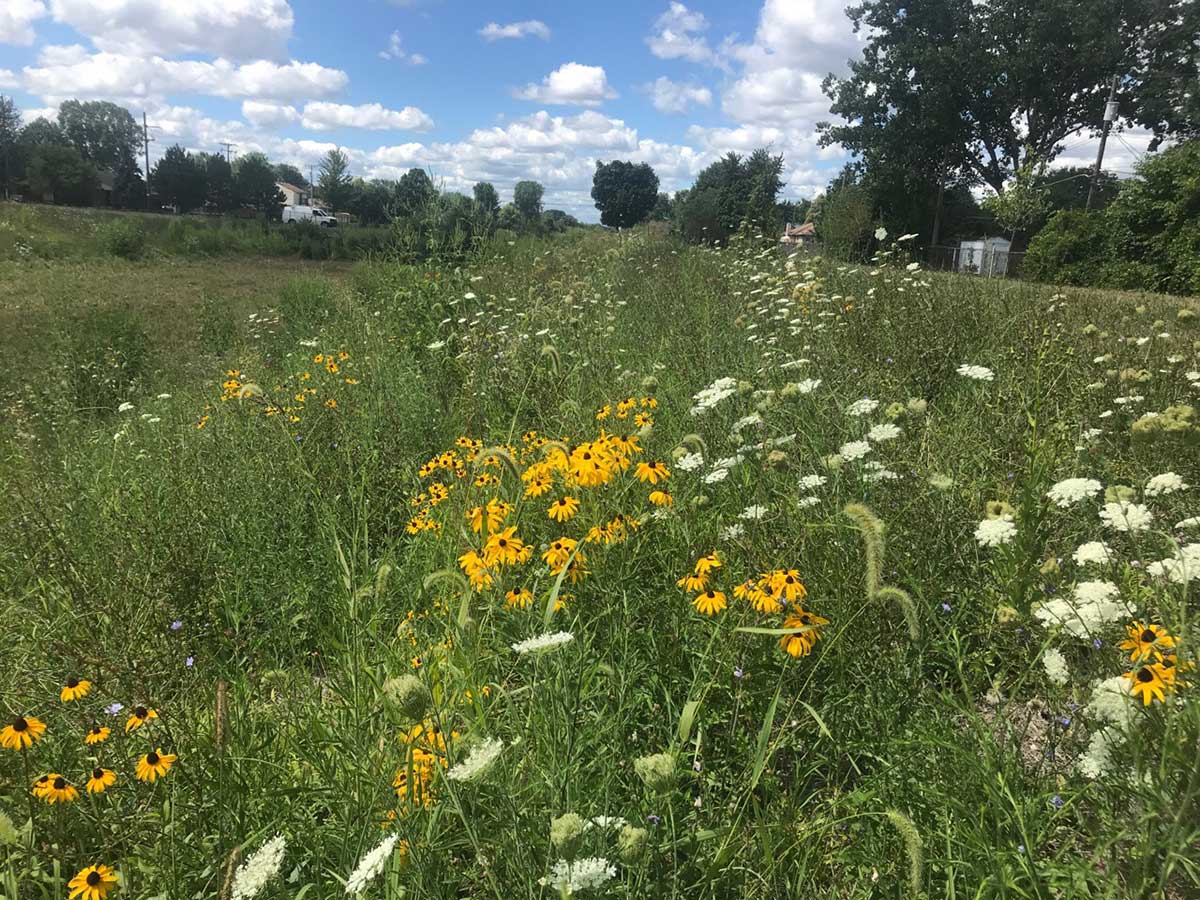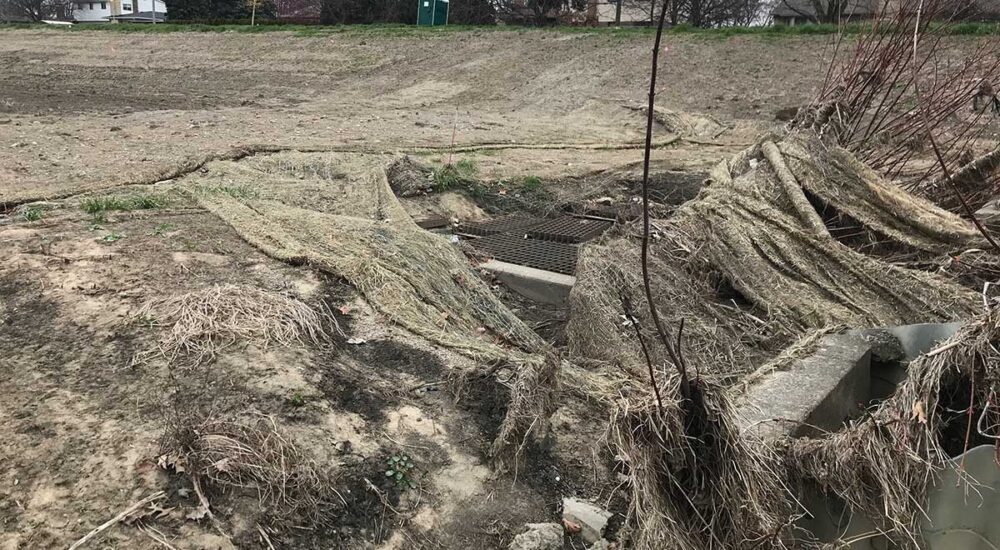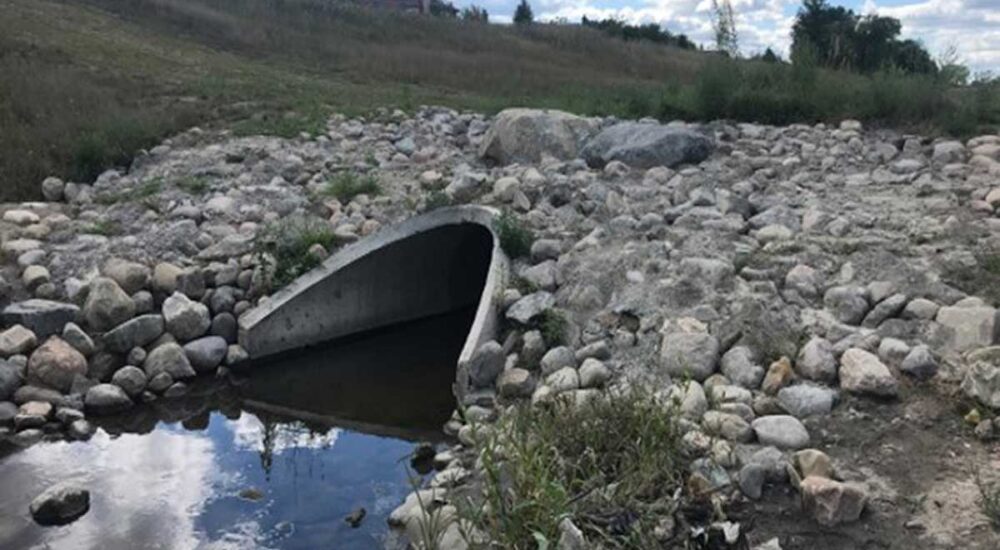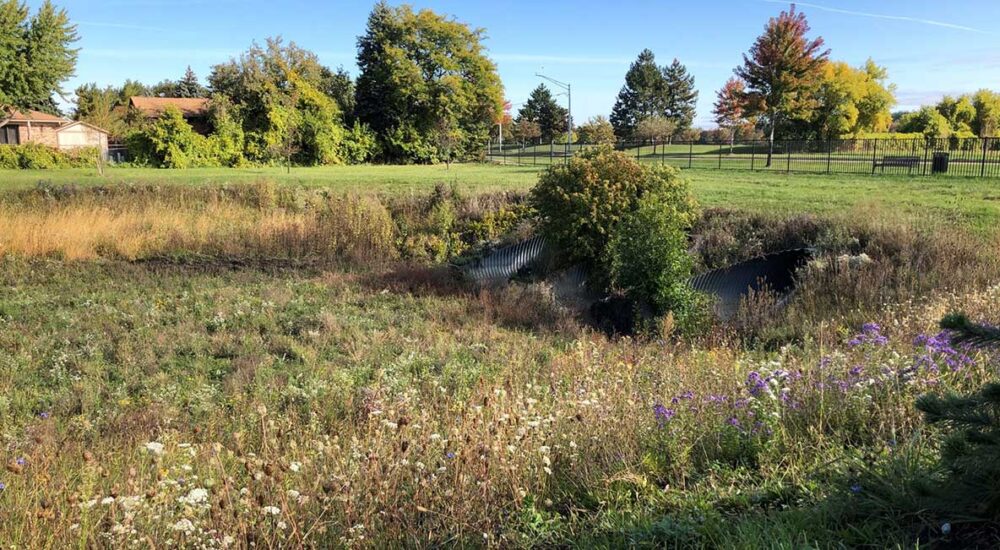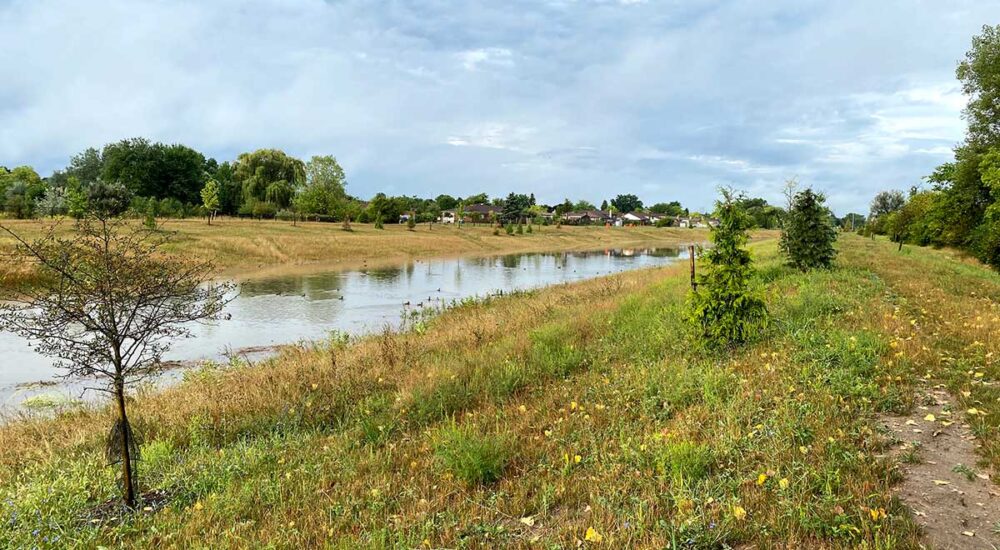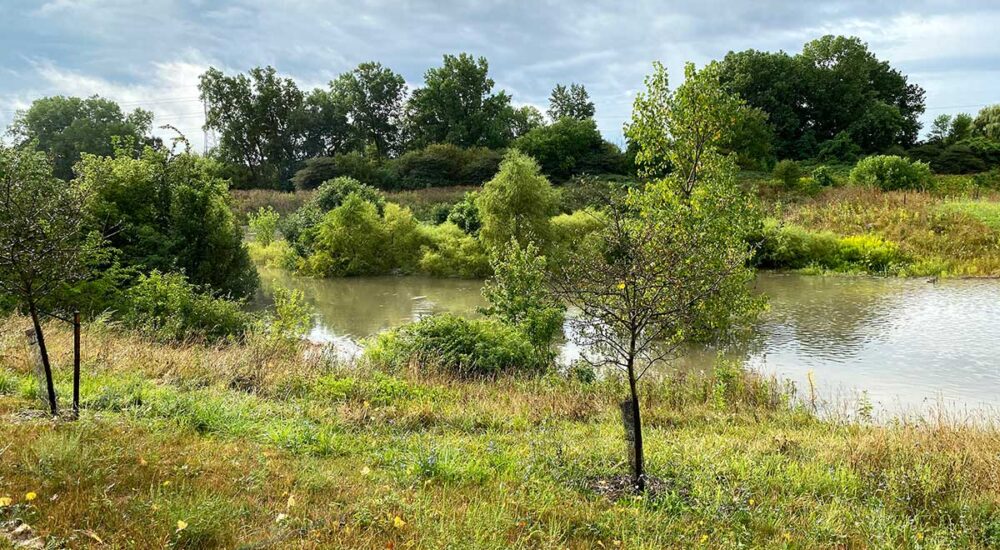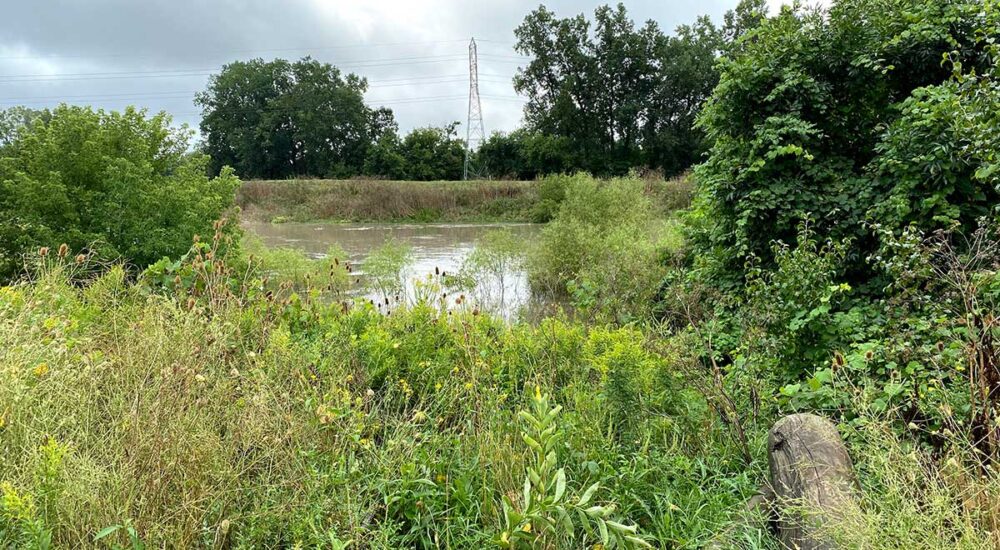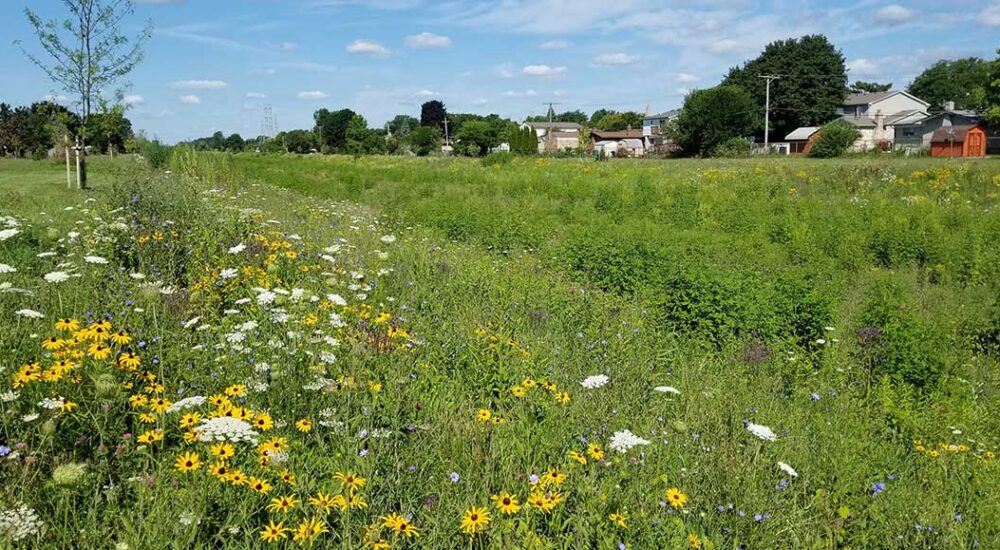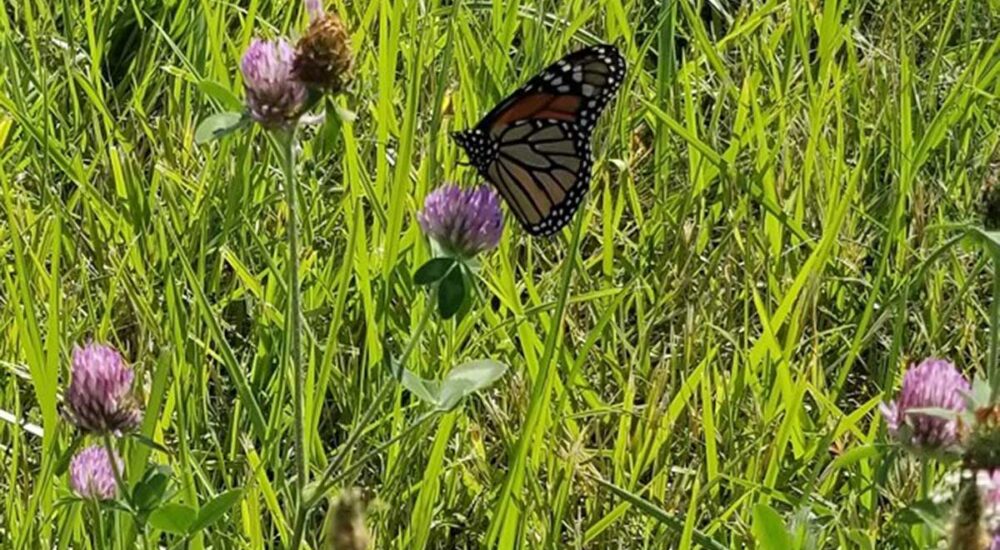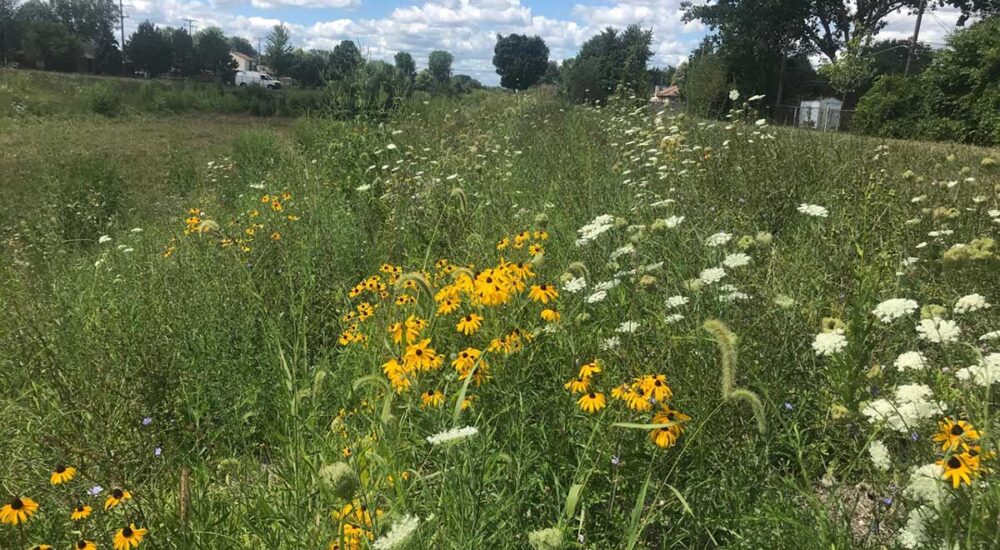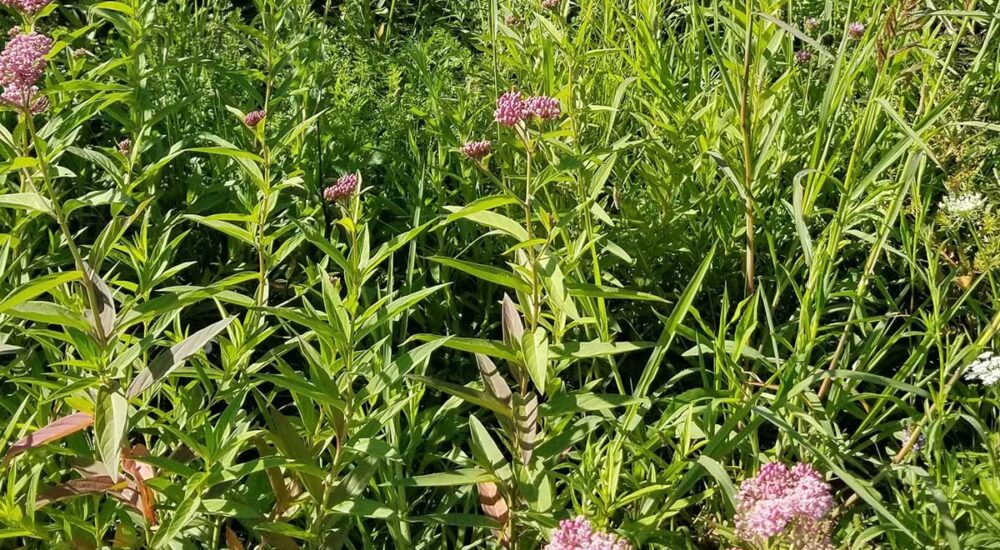Hubbell Roth & Clark, Inc. (HRC), brought together a team of professional subject matter experts to assist the Macomb County Public Works Commissioner’s Office in the design and construction of two miles of green infrastructure enhancements to improve water quality entering the Red Run Drain. The team members assisted with grant funding, baseline data collection, the design of improvements, permitting, and construction administration. HRC utilized the data to design, manage, and oversee construction of a financially viable and thriving green infrastructure project.
Introduction
Sterling Heights, the fourth largest city in Michigan, is home to the Sterling Relief Drain. The Drain has an 1,870-acre urban drainage district that serves over 27,000 people. The District is 30% impervious surface and provides drainage to three auto assembly plants and several major defense contractors.
The Sterling Relief Drain was originally designed in 1970 as a 4-foot diameter concrete pipe that served as an underdrain to an open, mowed grass trapezoidal channel. The underdrain carried all flow except in extreme storm events, when the large trapezoidal channel began to fill with stormwater. Lateral storm sewers collected urban drainage, which were directly connected to the underdrain. The underdrain ultimately served as a direct, untreated conduit to the Red Run Drain. Historically, the entire 250 ft wide drain corridor was maintained as mowed grass.
The U.S. Environmental Protection Agency’s (EPA) Great Lakes Restoration Initiative grant number GL-00E02350, and the National Fish & Wildlife Foundation’s Sustain Our Great Lakes (SOGL) grant program provided funding to the Macomb County Public Works Office (MCPWO) for the Sterling Relief Drain Daylighting project. The primary goal of this project was to redesign and retrofit approximately two miles of open channel drain, from Van Dyke Road to its outlet into the Red Run Drain, force flows out of the underdrain into the green corridor, and intercept and daylight lateral storm drains to reduce, slow, and filter urban stormwater runoff prior to entering the Red Run Drain and Clinton River. Clean water is not only vital to everyone’s quality of life, but it can also serve as a critical component of economic development in the region. Furthermore, the project aimed to create native and resilient habitat and provide accessible recreational opportunities in an area with no County owned and operated parks and limited trails. What once resembled a utility right of way has now turned into an extensive green infrastructure system that not only enhances the water quality for a sizeable drainage district, but it also provides park access to a resilient and natural recreation area.
Project Goals
- Improve water quality
- Physically slow and retain runoff
- Use appropriate plants to filter urban stormwater
- Increase water storage capacity of the Sterling Relief Drain open channel
- Create an ecologically diverse and resilient natural habitat corridor
- Support native pollinators
- Connect natural areas and corridors (Big Beaver Creek, Red Run, Clinton River)
- Provide accessible natural area recreation opportunities
- Provide regional linkages to community and county recreational facilities
Partnerships
Led by the Macomb County Public Works Commissioner’s Office (MCPWO) the Sterling Relief Drain Daylighting project forged a strong partnership between federal, County, and local governments, private consultants, and nonprofit agencies. The primary funding was provided through the U.S. Environmental Protection Agency (EPA) and the National Fish & Wildlife Foundation (Sustain Our Great Lakes Program). Additional support was also received from Green Macomb and ReLeaf Michigan. The Clinton River Watershed Council (CRWC) was a major partner providing baseline data, as well as continued monitoring. Heavily driven by MCPWO, the solid working relationships between all of these organizations provided incredible support to the Engineer and Contractor from the initial phases of the project through its completion. HRC and MCPWO have had a longstanding working relationship spanning over 40 years and have completed multiple successful grant projects together.
Design & Construction
For Macomb County Public Works Commissioner’s Office, the Sterling Relief Drain Project was the first ever drain project to use a design-build approach. MCPWO had a vision for their dream project which spearheaded into even more quality-of-life enhancements for surrounding neighbors. This project, funded through grants, had a fixed budget. Going the design-build route helped to maximize the use of the budget and accomplish more than originally intended. The early collaboration allowed for reduced engineering costs and more money left available for construction and landscaping.
The contractor, T.R. Pieprzak, along with the skilled design-build team with oversight from the project manager had monthly design meetings to ensure the best outcome on the project. The landscaping team, which included Sherman Nursery Farms and InSite Design Studio, came up with the best possible native plants and plugs for the area.
The Sterling Relief Drain corridor was redesigned to manage runoff from smaller rain events, including the first and most polluted portion of larger storm events. The primary goal of this project is to improve the water quality entering the Red Run Drain by treating the first flush rain event within the two-mile Sterling Relief corridor. The Sterling Relief Drain was originally designed with 28 lateral drains that directly connected to the 48-inch underdrain providing stormwater drainage from the nearby roads and subdivisions. Through the EPA and SOGL grant projects, 2 lateral drains were diverted from the underdrain and daylighted so that stormwater would directly discharge to the open channel. To daylight the remaining flow, 10 removable restrictor plates were installed in the underdrain to force flows to the surface for treatment.
The open channel was modified to create treatment cells by constructing berms and raising structures. Storm sewer structures were raised to allow for stormwater storage and treatment, forcing the water to be filtered through the native plantings that were incorporated into the design. Berms were constructed to assist in creating stormwater treatment cells and to provide maintenance access across the drain.
By daylighting the lateral drain connections, restricting the underdrain flow to the surface, constructing berms, and raising the inlet to the underdrain through the use of standpipes, stormwater will first flow into the open channel, infiltrate into the ground, and only enter the underdrain once the water level in the channel rises above the overflow standpipes. In addition, 300 feet of the 48-inch drain was removed near the end of the system in order to fully daylight the runoff before it enters the Red Run Drain. Two check dams were placed in this area for further improvement of water quality. This design was implemented as the final treatment and sediment sump of the water entering the Red Run Drain.
While the design behind this project sought to improve the water quality of water entering the Red Run Drain, it also looked to improve the quality of life for the people in this area. This project took a dull, unimpressive grass area and turned it into a flourishing habitat with beautiful features. Around 40 acres of habitat was created in this project with almost 1,400 shrubs and over 500 trees all native to the area being planted. It provides space and resources that allow a declining monarch butterfly population to live and grow. In an area that is predominately urban it brings a change of scenery to the residents with native flowers and a grass path through newly planted trees. This project was the kickstart to establishing a five-mile-long linear park in the community.
Construction began in June 2019 and was completed in September of 2020. Project monitoring and plant maintenance is still ongoing. Despite bouts of adverse weather and disruptions due to COVID-19, no time extensions were needed to complete the project on time. Macomb County Public Works Office used a design-build process to maximize the amount of time and money spent in the field. This allowed the contractor to have more design flexibility based on actual field conditions. Monthly design meetings and a stringent project schedule were also employed to ensure that the project remained on track for its contracted completion date.
Major Accomplishments
- Redesign and retrofit approximately 2 miles of green infrastructure in a highly urbanized area
- Improve the water quality entering the Red Run Drain.
- Created an ecologically diverse and resilient natural habitat corridor.
- Improved water quality before discharging into Lake Saint Clair
- Increased Drain storage capacity
- Greatly reduced the area of required mowing and upkeep
- Created a butterfly flyway in the Drain to attract Monarch butterflies to the area
- Restored connectivity and long-term stability of the drain
- Designed to capture and treat 157 million gallons of urban storm water runoff per year (46% of the total yearly runoff from the district)
- 3,500 lbs/yr of Nitrogen will be prevented from entering the system
- 600 lbs/yr of Phosphorus will be prevented from entering the system
- 200 lbs/yr of sediment captured (68% of the yearly sediment load)
- Six +/- acres open channel bottom: wet-mesic prairie/stormwater infiltration zone
- Nine +/- acres channel slopes: Dry-mesic prairie plus scrub/shrub
- Five +/- acres riparian tree canopy and low-profile prairie.
- Five +/- acres lateral bioretention swales to retain and infiltrate local drainage.
- Creating approximately 40 total acres of habitat through ecological restoration, including:
- Restoration of fifteen ± acres of open channel bottom: wet-mesic prairie/stormwater infiltration
- Restoration of twenty-five ± acres of riparian tree canopy and low-profile prairie
- Total Plant Numbers:
- 1,396 shrubs
- 150 small liner trees
- 463 2” caliper trees
- 160,650 native perennial plugs
Community Relations
As with any project that is adjacent to a residential area, the cooperation and input of those individuals living within proximity and will be impacted by the construction as well as the project outcome, are essential. Multiple flyers were mailed out to residents before work began to alert them of the upcoming project to improve relations.
The Sterling Relief Drain, at its inception, was designed to be utilitarian. It served its purposes but contributed little to the community. The redesign and implementation of the project changed and improved the quality of life for the community. InSite Design Studio was added to the team for their expertise in designing bioretention systems. With the project site adjacent to residential backyards, it was important that the design of the bioretention areas not only be functional and low maintenance, but aesthetically pleasing.
Macomb County lacks county-owned parks and has limited trails. This project helped to break up the suburban environment with the addition of a natural habitat and walkable park. The Drain was designed and trees planted specifically for a walkable grass pathway with the understanding that a more permanent pathway, which is currently being developed, will replace it. This 5-mile-long linear park is now an asset to the community. The project exceeded expectations and the outcome has been noted by residents and the community alike as they sit on their patios to enjoy the new view or walk their dogs along the grass path.
Macomb County held a tree planting event for Sterling Relief on November 1, 2019. Even during a very brisk day, dozens of volunteers from the community showed up to take part. The planting event was very successful and was posted on the Sterling Heights’ YouTube channel, https://www.youtube.com/watch?v=cwP-HcW8IPw&t=7s.
Environmental Considerations
Besides intercepting urban stormwater drainage and improving water quality, this project retrofitted the Sterling Relief Drain with additional green infrastructure and created a diversity of natural habitat zones across the 250 ft wide drain corridor. These habitat zones will restore the natural processes that remove and breakdown contaminants and pollution from urban runoff, while creating an uninterrupted natural corridor.
Most noticeable to the area residents is the daylighting of portions of the drain to make it appear more like a natural creek. InSite Design Studio and Sherman Nursery were extremely helpful in the plantings of 1,396 shrubs, over 500 trees, and 160,650 native pollinator perennial plugs. The landscaping now acts like a natural sponge that absorbs materials from stormwater runoff that could negatively impact the local waterways. The project also increased the volume of water that the drain can handle to capture and treat 157 million gallons of urban stormwater runoff and provided much needed native habitat for important species like the monarch butterfly in a highly urbanized area.
Special steps that were taken to preserve and protect the environment during the construction phase included having a soil erosion permit. All permit measures were adhered to. Additionally, methods were used and the project contract was modified to combat the force of the drain during high flow events. The Sterling Relief Drain is a flashy system that sometimes flooded the site so extra care had to be taken.
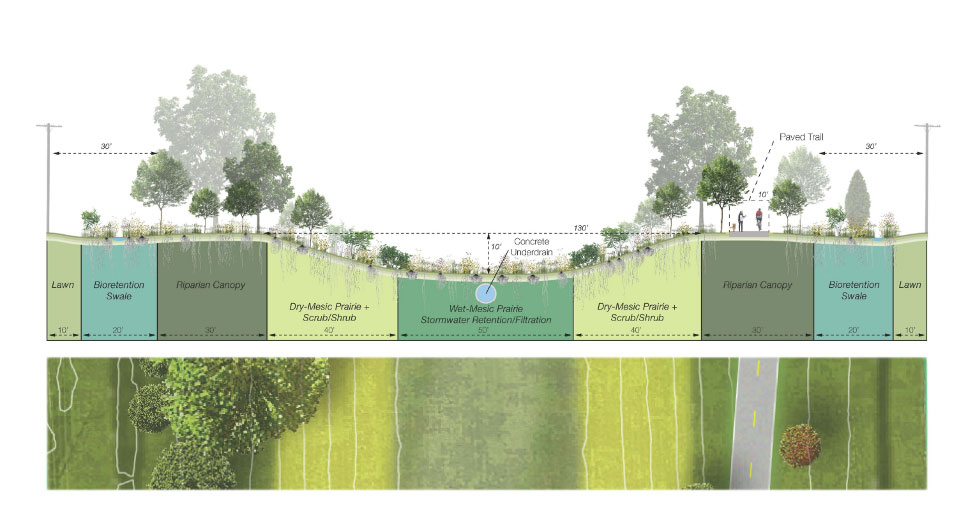
The project gave a strong priority to tree species native to Michigan. However, additional consideration was given to other species in the context of migrating USDA Plant Hardiness Zone boundaries and overall resilience of the urban forest to climate variability, pests, and disease. The project prioritized those species that support the greatest biodiversity while also creating a resilient landscape capable of adapting to changing temperatures and extreme weather conditions.
Diverse species were selected to maintain healthy ecosystems, provide varied habitat, minimize potential impacts of pests, and increase resiliency of the urban forest system but site appropriateness, availability, and quality of trees ultimate determined final species used. Plantings also included a variety of species, genus, and family towards the 10-20-30 rule for tree diversity.
Ecological restoration included riparian reforestation along the top of the channel banks, peripheral bioretention swales to capture local drainage, a variety of native prairie pollinator plantings and scrub/shrub along the channel slopes, and wet-mesic prairie in the retention/infiltration zone across the channel bottom. As a result, the project will benefit aquatic primary producers upstream and thus nearshore species of conservation concern such as northern pike, lake sturgeon, waterfowl, and shorebirds downstream. Riparian habitat restoration included native herbaceous grasses and flowers, shrubs, and trees. Future impacts will be even greater as plants establish, grow, and mature – including greater canopy benefits and increased infiltration rates from the formation of deep-rooted systems.
Pre- and post-construction monitoring was also included in the project to ensure that the Drain functions as it was intended. Such monitoring activities included:
- Macroinvertebrate and habitat sampling pre- and post-construction at the Sterling Relief drain confluence with the Red Run
- HOBO temperature pendent deployment at the Red Run confluence throughout the duration of the project
- Temperature, pH, Conductivity, and Total Suspended Solids testing pre- and post-construction at the Red Run confluence
- Pre and post construction flow meter measurements at the Red Run confluence
- Michigan Frog and Toad survey at two locations pre- and post-construction
Unusual Accomplishments
The Sterling Relief Project employed an innovative solution to intercept and daylight stormwater from lateral collector drains before entering the Red Run via the main underdrain conduit below the Sterling Relief Drain. The project greatly improved the water quality of stormwater runoff along the two miles of the Sterling Relief Drain corridor.
Extensive planning with all of those involved or affected by the project was a crucial achievement. In addition to the contractors, this project had many different collaborators including:
- Red Run Drainage Board
- U.S. Environmental Protection Agency
- City of Sterling Heights
- Clinton River Watershed Council
- Macomb County Planning and Economic Development Office
- Macomb County Department of Roads
Frequent on-site meetings and active correspondence with participating agencies and affected homeowners was key to maintaining a safe, effective, and high-quality work environment for everyone. When working in the backyards of peoples’ property it was important to remain transparent and answer any questions or concerns a homeowner would have about the project. Little disruption to the community was also of the utmost importance.
Another challenge that was overcome during this project was maintaining the integrity of new construction during rain events. While construction was taking place, the drain was still in use with high flows and backwater conditions from the Red Run Drain. The drain had to be able to sustain the same preconstruction base flow and drainage capabilities throughout the project. This was partially accomplished by prompt planting and seeding. Areas that were designed to be seeded or planted were done as soon as they were constructed in order to stabilize the drain capacity during rain events. These natural habitats that were created aid in the removal and breakdown of contaminants and pollution from urban runoff.
An extra feature of the swift planting was the immediate presence of butterflies throughout the site adding beauty and aesthetics to a once plain grassy area. A mix of native grasses and flowers that are known to attract butterflies were selected to create a “butterfly alley” along the drain. A major success of the project was creating an ecologically diverse corridor that promotes pollinators, reduces erosion, and helps filter pollutants. Ecological restoration created approximately 40 acres of habitat with around 15 acres of open channel bottom and 25 acres of riparian tree canopy and low-profile prairie.
Additional Considerations
Educational Resource
The creation of the butterfly alley along the drainage corridor proved to be a source of both beauty and education. A local elementary school raised monarch butterflies and then released them into the Sterling Relief Drain where plenty of milkweed and other native flowers allow them to flourish. Being in a highly urban area, it would have been hard to find a better location than this to release butterflies to and provide an educational experience to young kids. The Drain has also been used as an outdoor classroom to provide students with a scenic learning environment.
Alternatives Used
Climate Change Resilliency
Restoring and increasing urban tree canopies is a pivotal way to combat climate change at the local level. The Sterling Relief Drain project added over 500 trees to the area. Green Macomb and ReLeaf Michigan, two non-profit tree planting organizations, planted dozens of trees along the drain. The involvement of these organizations helped to increase community awareness about the benefits of green infrastructure.
The flowers and grasses that were planted along the drain were carefully selected to be resilient under the current climate conditions. Native grasses and flowers that can survive flooding after large rain events and still be able to thrive when there is not constant flowing water through the drain were selected. A very divergent list of plants was planted, and they are expected to withstand future climate conditions.
Innovations in Technology
This drainage system was designed with sustainability in mind. The restrictors along the drain can adapt as the conditions of the watershed change over the years. The size of the restrictor can be increased, decreased, or the restrictor can be removed altogether. This was designed purposely with the knowledge that the watershed is subject to change as the infrastructure in the area changes.
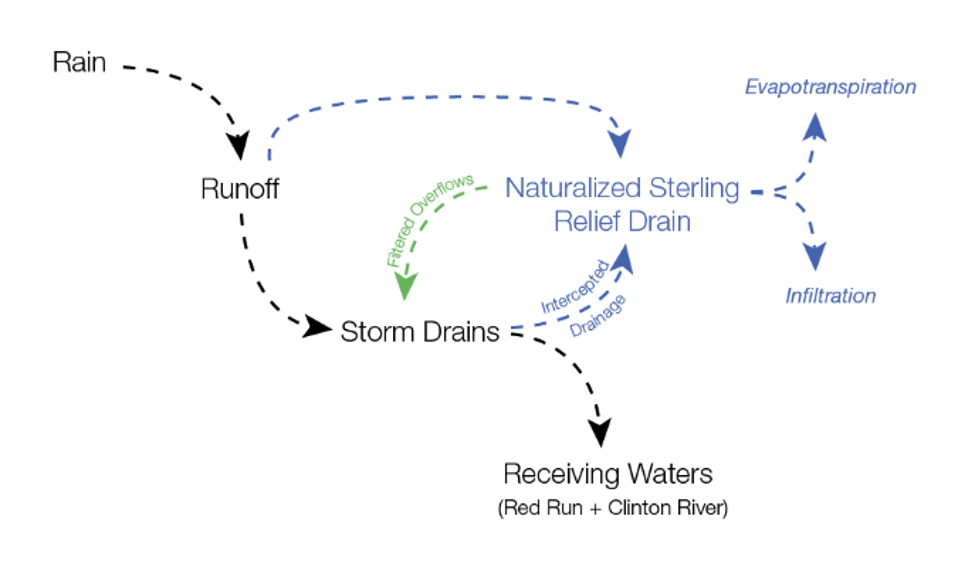
Exceeding Client/Owner Needs
The Sterling Relief Drain Project met and exceeded the Macomb County Public Works Commissioner’s Office expectations and needs. The project exceeded the grant obligations and more work than intended was accomplished. Green Macomb and ReLeaf Michigan coordinated tree planting as well as watering. As a result of the grant, more physical improvements were brought to the area. The contractor was gracious in moving trees and other landscaping aspects around that was out of their scope of work. The project was completed on time despite setbacks from COVID-19, downtime due to rain events, and invasive species control parameters.


